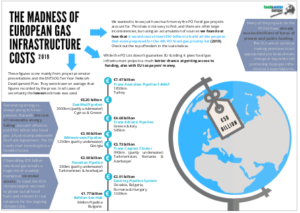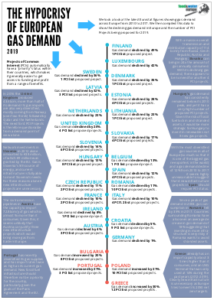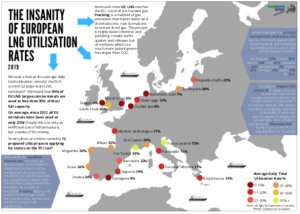Europe’s Big Bet on Gas Would Be a Climate Disaster
The 'Projects of Common Interest' list includes dozens of unnecessary, polluting fossil fuel projects that put corporate interests over a livable climate. Three infographics explain why the gas PCI List is nothing but a list of "Projects of Corporate Interests."
 Three infographics show how the “Projects of Common Interest” list is really about serving corporate interests
Three infographics show how the “Projects of Common Interest” list is really about serving corporate interests
Every year, the European Commission releases a list of “Projects of Common Interest” (PCI List) for future gas infrastructure. In 2017, the final PCI List included around 50 gas projects; however, in reality there were about 100 projects, since many had been clustered together.
This year looks set to be no different, with over 110 projects being proposed for the fourth PCI List that will be published in October.
With calls from scientists and energy experts to stop investing in new gas infrastructure immediately, and a pressing need to decarbonise in order to meet the goals of the Paris Agreement, putting dozens of new fossil gas projects on a priority list would represent a dangerous step away from staying below 2 degrees of global temperature increase.
To help understand just how counterintuitive these new gas infrastructure proposals are, it is important to look at the wider picture.

Declining Demand
Across Europe, gas demand on average has been in decline since it peaked in 2010. But this hasn’t slowed down the push for new gas infrastructure. From looking at the average gas demand changes per country from 2010 to 2017 and the number of new PCI projects being proposed for the 2019 list, it is clear that there is a disconnect between declining gas demand and the new gas infrastructure being proposed.
Moreover, in order to reach EU climate targets, gas demand will need to decline further—and rapidly. This demonstrates that the PCI List is putting profit before practicality, but sales before sense. And, on top of these “priority projects” within the EU, many more fossil gas projects are being planned and built without the support the PCI List provides
New LNG Facilities: Completely Unnecessary
Liquified Natural Gas (LNG) is a way of transporting gas in its liquid form, especially o ver large distances. However, it requires infrastructure to liquefy it and regasify it when it arrives; this costs money, uses more energy and creates more emissions.
ver large distances. However, it requires infrastructure to liquefy it and regasify it when it arrives; this costs money, uses more energy and creates more emissions.
Currently across Europe, there are 22 large-scale LNG terminals, but 90% are being used at less than 50% of their full capacity. And yet, there are 12 LNG terminal projects being proposed on the 2019 PCI List.
Given the inefficiency of current LNG infrastructure in Europe and the threatening climate crisis, proposing new LNG terminals seems not only unnecessary but utterly dangerous. More LNG terminals will slow down our ability to transition to renewables, channel more money into the fossil fuel sector and contribute further to climate chaos.
Massive Infrastructure= Stranded Assets
Aside from the clear environmental and climate impacts of extending gas infrastructure across Europe, there is a huge economic cost. The cost of all the proposed gas infrastructure on the 2019 draft PCI list would be at least €51 billion! This kind of investment not only distracts us from climate action, but is likely to result in massive stranded assets further down the line as we move towards renewables.
You can find the infographics here:
Hypocrisy of European Gas Demand
Insanity of European LNG Utilisation Rates
The Madness of European Gas Infrastructure Cost
The 4th draft PCI list (status 17 October 2019) is here.
The letter signed by over 80 Civil Society Organizations is here.
Our briefing on the final 4th PCI list draft is here.


